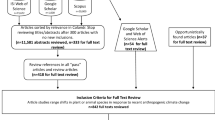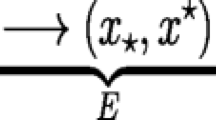Abstract
Many species are experiencing range shifts as the climate warms. Earlier models have considered moving-habitat scenarios where the shift speed of the moving habitat is either constant or fluctuates around a constant speed. This paper considers scenarios where the shifting speed may either be constant or accelerated. In addition to population persistence, the paper also analyzes the range-shift deficit, which is a lag in the spatial distribution of the population. Another highlight of the results is an analytic formula for a population persistence metric in a particular example, which adds to existing analytic formulas about this persistence metric in the literature.






Similar content being viewed by others
References
Alexander JM, Chalmandrier L, Lenoir J, Burgess TI, Essl F, Haider S, Kueffer C, McDougall K, Milbau A, Nuñez MA et al (2018) Lags in the response of mountain plant communities to climate change. Glob Change Biol 24(2):563–579
Bajo I (2014) Forbidden sets of planar rational systems of difference equations with common denominator. Appl Anal Discrete Math 8:16–32
Bedford FE, Whittaker RJ, Kerr JT (2012) Systemic range shift lags among a pollinator species assemblage following rapid climate change. Botany 90(7):587–597
Berestycki H, Fang J (2018) Forced waves of the Fisher–KPP equation in a shifting environment. J Differ Equ 264(3):2157–2183
Berestycki H, Diekmann O, Nagelkerke CJ, Zegeling PA (2009) Can a species keep pace with a shifting climate? Bull Math Biol 71(2):399
Berestycki H, Desvillettes L, Diekmann O (2014) Can climate change lead to gap formation? Ecol Complex 20:264–270
Bertrand R, Lenoir J, Piedallu C, Riofrio-Dillon G, de Ruffray P, Vidal C, Pierrat J-C, Gégout J-C (2011) Changes in plant community composition lag behind climate warming in lowland forests. Nature 479(7374):517–520
Beverton RJH, Holt SJ (1957) On the dynamics of exploited fish populations. Her Majesty’s Stationery Office, London
Bouhours J, Lewis MA (2016) Climate change and integrodifference equations in a stochastic environment. Bull Math Biol 78:1866–1903
Cobbold CA, Stana R (2020) Should i stay or should i go: partially sedentary populations can outperform fully dispersing populations in response to climate-induced range shifts. Bull Math Biol 82(2):26
Devictor V, Van Swaay C, Brereton T, Brotons L, Chamberlain D, Heliölä J, Herrando S, Julliard R, Kuussaari M, Lindström Å et al (2012) Differences in the climatic debts of birds and butterflies at a continental scale. Nat Clim Change 2(2):121–124
Dullinger S, Gattringer A, Thuiller W, Moser D, Zimmermann NE, Guisan A, Willner W, Plutzar C, Leitner M, Mang T et al (2012) Extinction debt of high-mountain plants under twenty-first-century climate change. Nat Clim Change 2(8):619–622
Hu C, Shang J, Li B (2020) Spreading speeds for reaction-diffusion equations with a shifting habitat. J Dyn Differ Equ 32:1941–1964
Hurford A, Cobbold CA, Molnár PK (2019) Skewed temperature dependence affects range and abundance in a warming world. Proc R Soc B 286(1908):20191157
IPCC (2018) IPCC, 2018: summary for Policymakers. In: Global warming of 1.5\(\,^{\circ }\)C. An IPCC special report on the impacts of global warming of 1.5\(\,^{\circ }\)C above pre-industrial levels and related global greenhouse gas emission pathways, in the context of strengthening the global response to the threat of climate change, sustainable development, and efforts to eradicate poverty. World Meteorological Organization, Geneva, Switzerland, p 32
Jacobsen J, Jin Yu, Lewis MA (2015) Integrodifference models for persistence in temporally varying river environments. J Math Biol 70(3):549–590
Kot M, Phillips A (2015) Bounds for the critical speed of climate-driven moving-habitat models. Math Biosci 262:65–72
Latore J, Gould P, Mortimer AM (1998) Spatial dynamics and critical patch size of annual plant populations. J Theor Biol 190(3):277–285
Lewis MA, Marculis NG, Shen Z (2018) Integrodifference equations in the presence of climate change: persistence criterion, travelling waves and inside dynamics. J Math Biol 77(6–7):1649–1687
Li B, Bewick S, Barnard MR, Fagan WF (2016) Persistence and spreading speeds of integro-difference equations with an expanding or contracting habitat. Bull Math Biol 78(7):1337–1379
Li W-T, Wang J-B, Zhao X-Q (2018) Spatial dynamics of a nonlocal dispersal population model in a shifting environment. J Nonlinear Sci 28(4):1189–1219
Lindström Å, Green M, Paulson G, Smith HG, Devictor V (2013) Rapid changes in bird community composition at multiple temporal and spatial scales in response to recent climate change. Ecography 36(3):313–322
Lutscher F, Pachepsky E, Lewis MA (2005) The effect of dispersal patterns on stream populations. SIAM Rev 47(4):749–772
MacDonald JS, Lutscher F (2018) Individual behavior at habitat edges may help populations persist in moving habitats. J Math Biol 77(6–7):2049–2077
Marculis NG, Lewis MA (2020) Inside dynamics of integrodifference equations with mutations. Bull Math Biol 82(1):1–26
Marculis NG, Garnier J, Lui R, Lewis MA (2020) Inside dynamics for stage-structured integrodifference equations. J Math Biol 80(1–2):157–187
Potapov AB, Lewis MA (2004) Climate and competition: the effect of moving range boundaries on habitat invasibility. Bull Math Biol 66:975–1008
Shi T, Belkin M, Yu B (2008) Data spectroscopy: learning mixture models using eigenspaces of convolution operators. In: Proceedings of the 25th international conference on machine learning, Helsinki, Finland
Shi T, Belkin M, Yu B (2009) Data spectroctopy: eigenspaces of convolution operators and clustering. Ann Stat 37:3084–3960
Wang J-B, Zhao X-Q (2019) Uniqueness and global stability of forced waves in a shifting environment. Proc Am Math Soc 147(4):1467–1481
Wu C, Wang Y, Zou X (2019) Spatial-temporal dynamics of a Lotka–Volterra competition model with nonlocal dispersal under shifting environment. J Differ Equ 267(8):4890–4921
Yuan Y, Wang Y, Zou X (2019) Spatial dynamics of a Lotka–Volterra model with a shifting habitat. Discrete Contin Dyn Syst B 24(10):5633
Zanatta F, Engler R, Collart F, Broennimann O, Mateo RG, Papp B, Muñoz J, Baurain D, Guisan A, Vanderpoorten A (2020) Bryophytes are predicted to lag behind future climate change despite their high dispersal capacities. Nat Commun 11(1):1–9
Zhang Z, Wang W, Yang J (2017) Persistence versus extinction for two competing species under a climate change. Nonlinear Anal Model Control 22(3):285–302
Zhao X-Q (2003) Dynamical systems in population biology, vol 16. Springer, Berlin
Zhou Y (2013) Geographic range shifts under climate warming. Ph.D. thesis, University of Washington
Zhou Y, Fagan WF (2017) A discrete-time model for population persistence in habitats with time-varying sizes. J Math Biol 75(3):649–704
Zhou Y, Kot M (2011) Discrete-time growth-dispersal models with shifting species ranges. Theor Ecol 4:13–25
Zhou Y, Kot M (2013) Life on the move: modeling the effects of climate-driven range shifts with integrodifference equations. In: Lewis M, Maini P, Petrovskii S (eds) Dispersal, individual movement and spatial ecology. Lecture notes in mathematics, vol 2071. Springer, Berlin, Heidelberg. https://doi.org/10.1007/978-3-642-35497-7_9
Zhu H, Williams C, Rohwer R, Morcinie M (1998) Gaussian regression and optimal finite-dimensional linear models. In: Bishop C (ed) Neural networks and machine learning. Springer, Berlin
Acknowledgements
This manuscript includes ideas that originated in the Ph.D. thesis of the author, but have been improved and generalized to a large extent since the submission of the thesis. The author wishes to thank all the reviewers for their constructive feedback.
Author information
Authors and Affiliations
Corresponding author
Additional information
Publisher's Note
Springer Nature remains neutral with regard to jurisdictional claims in published maps and institutional affiliations.
Rights and permissions
About this article
Cite this article
Zhou, Y. Range Shifts Under Constant-Speed and Accelerated Climate Warming. Bull Math Biol 84, 1 (2022). https://doi.org/10.1007/s11538-021-00963-8
Received:
Accepted:
Published:
DOI: https://doi.org/10.1007/s11538-021-00963-8




